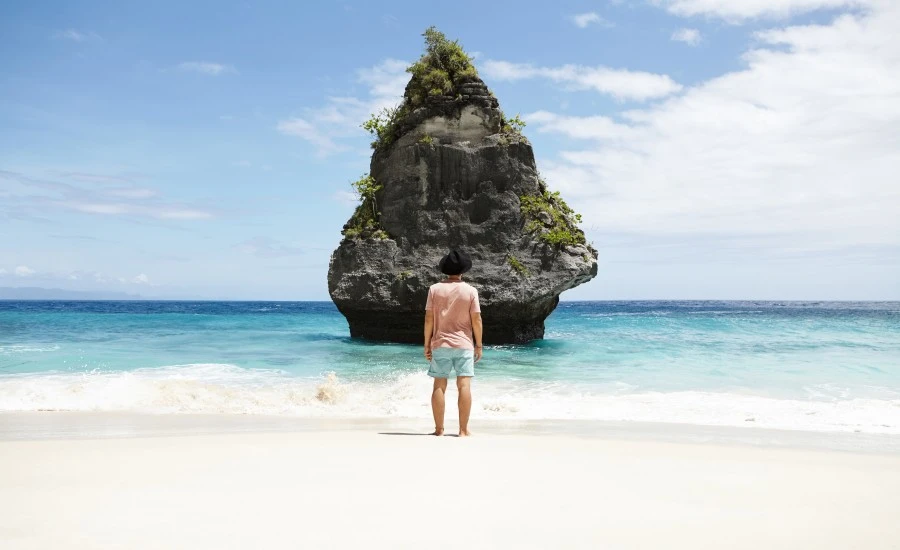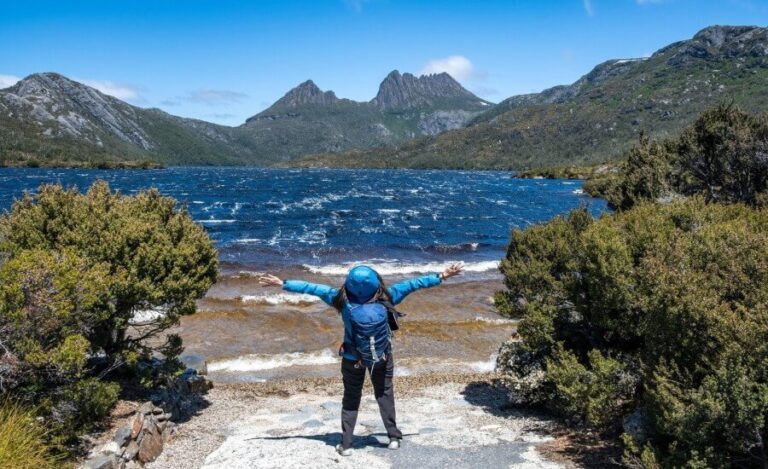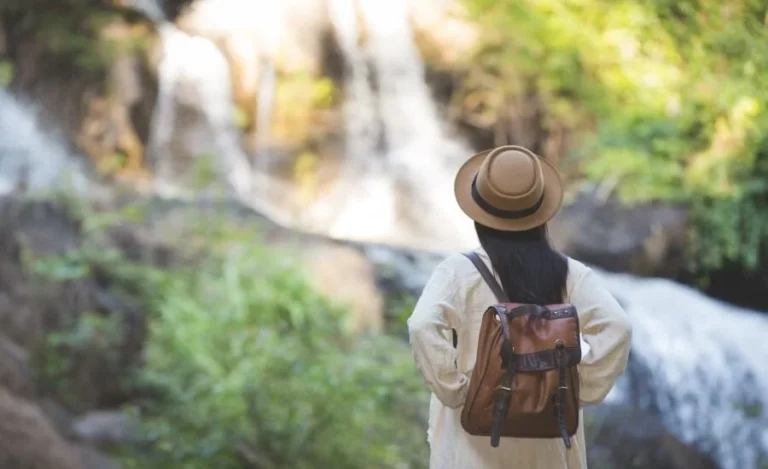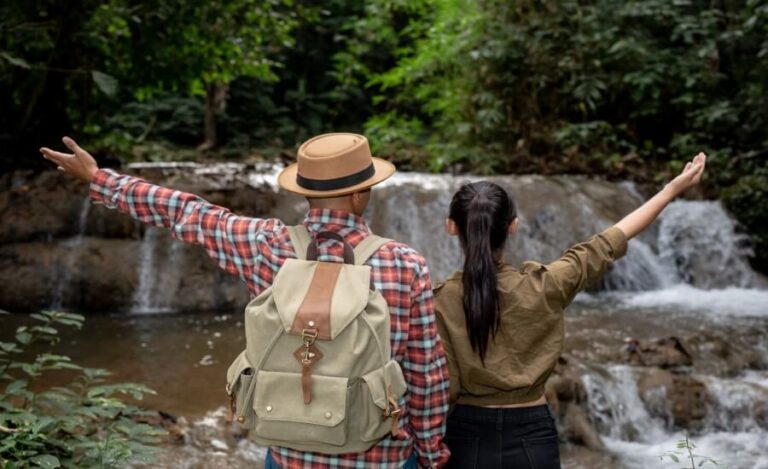
The first time I experienced true presence on a beach, I was sitting on a deserted stretch of sand in southern Thailand. It was dawn, and I’d deliberately left my phone back in my simple beachfront bungalow. As the sun painted the sky in gradient hues, I noticed something profound – without a screen to capture the moment, I was actually experiencing it fully. The texture of sand between my toes, the rhythmic percussion of waves, the salt-laden breeze against my skin – all of it entered my awareness with an intensity I’d forgotten was possible.
That morning changed my relationship with travel forever. Over the past decade, I’ve dedicated myself to finding the world’s most pristine, untouched beaches specifically for the practice of meditation and mindfulness. Not the Instagram-famous shores packed with sun loungers and beach bars, but the hidden sanctuaries where solitude isn’t just possible – it’s inevitable.
I’m sharing my ten most treasured discoveries – places where the unique combination of natural beauty, minimal development, and what I’ve come to call “natural mindfulness triggers” create perfect conditions for presence. These aren’t just beautiful beaches; they’re natural temples for reconnecting with yourself and the world in ways increasingly difficult in our hyper-connected lives.
What Makes a Beach Perfect for Meditation?
Through years of beach meditation practice and countless conversations with fellow mindful travelers, I’ve identified specific qualities that make certain beaches extraordinary sanctuaries for contemplative practice.
The Rhythm of Water and Mind
I’ve noticed that beaches with particular wave patterns seem to entrain brainwave states conducive to meditation. Shores with consistent, rhythmic waves arriving at approximately 8-12 second intervals – matching the alpha brainwave frequency – naturally support meditative states without effort.
During my practice on Mexico’s hidden Pacific shores, I discovered that timing my breath with these wave intervals created a profound state of coherence I rarely achieve in formal meditation settings. The ocean becomes a natural meditation teacher, guiding the mind toward synchrony through its timeless rhythm.
Sound Qualities That Support Presence
Not all beach soundscapes are created equal for mindfulness practice. Through my travels, I’ve become particularly attuned to the acoustic qualities that support presence:
- Beaches tucked into natural coves that dampen distant sounds
- Shores with fine sand that produces minimal footstep noise
- Locations free from the particular frequency range of motorized watercraft
- Natural sound barriers like cliffs or vegetation that create “sound sanctuaries”
I remember discovering a hidden cove in Portugal where the unique rock formation created what sound engineers would call a “diffusion field” – sound didn’t echo harshly or disappear completely, but rather gently dispersed, creating an audio environment that naturally calmed the nervous system and supported awareness practices.
Light Quality and Circadian Reset
The most powerful beaches for meditation offer specific light qualities that trigger what neuroscientists call “circadian reset” – a reestablishment of our natural biological rhythms disrupted by artificial lighting and screen exposure.
I’ve found that beaches facing east, with unobstructed sunrise views, offer a particular gift – the opportunity to synchronize your internal clock with the earth’s actual rhythms. After just three mornings of sunrise meditation on an east-facing beach in Sri Lanka, I noticed my sleep deepening, dream recall improving, and a natural waking just before dawn that persisted for weeks afterward.
10 Best Untouched Beaches for Meditation
Have you ever noticed how time seems to expand on an empty beach? How the constant cognitive switching of digital life gives way to sustained attention? These aren’t just pleasant experiences but profound nervous system recalibrations increasingly essential in our fragmented attention economy.
1. Hidden Coast of Galicia: Spain’s Atlantic Meditation Sanctuary

I discovered this remote stretch of Spanish coastline during a pilgrimage on the less-traveled northern route to Santiago de Compostela. Veering off the traditional path one misty morning, I followed a barely visible trail through eucalyptus forests that suddenly opened onto a series of hidden coves protected by towering cliffs.
My Personal Experience
What makes this coastline exceptional for meditation is its microclimate – frequent morning mists create a natural sensory deprivation that heightens remaining perception. The first time I practiced meditation here, sitting on smooth granite rocks warmed by the early sun peeking through dissipating fog, I experienced a rare quality of attention that seemed to emerge from the landscape itself.
The beach revealed itself differently with each visit. Some mornings, the mist was so thick I could barely see the water’s edge from my meditation spot; only the rhythmic sound of waves guided my awareness. Other days, dramatic clarity prevailed, with visibility extending to distant islands that local legend claims were once sacred sites for pre-Christian contemplative practices.
For seven consecutive days, I arrived before dawn, sitting in meditation as day broke, and each morning unveiled a completely different sensory experience – a natural lesson in impermanence and presence.
Mindfulness Practice Here
The Galician coast taught me a practice I now call “mist meditation” – using the shifting visibility as an object of attention:
- Find a safe sitting spot facing the ocean
- As the morning mist shifts, notice how landmarks appear and disappear
- Use this natural phenomenon as a metaphor for how thoughts arise and dissolve
- Allow your attention to mirror the quality of the mist itself – sometimes clear, sometimes obscured, always changing
This coast also offers perfect conditions for walking meditation along firm, wet sand exposed during low tide, with the rhythmic crash of Atlantic waves entraining brainwave states associated with insight and creativity.
Finding Solitude
I accessed this sanctuary by staying in the small fishing village of Malpica, deliberately visiting during October when pilgrim traffic diminishes and before winter storms make the coast inhospitable. Even during summer, morning meditation remains possible by arriving before 7:00 am when most Spanish beachgoers are hours from their first café con leche.
The most pristine sections lie between Playa de Seaia and Cabo San Adrián, requiring a 30-minute walk from the nearest access point – just enough effort to deter casual visitors but accessible enough for daily practice.
2. Awaroa Bay: New Zealand’s Tidal Meditation Sanctuary
I first heard about Awaroa from a Zen priest I met while hiking in New Zealand’s Abel Tasman National Park. “There’s a beach where time behaves differently,” he told me. Intrigued, I adjusted my itinerary to experience this place accessible only by hiking, boat, or small aircraft – and only at specific tide times.
My Personal Experience
Arriving at Awaroa after a four-hour hike through ancient podocarp forest, I emerged onto golden sands that seemed to extend infinitely in both directions. What immediately struck me was the quality of silence – a rich, textured quiet punctuated only by distant birdsong and gentle wave percussion.
The beach’s unique tidal patterns create what I can only describe as “temporary islands of consciousness” – sandbars that emerge and disappear with the rhythms of the ocean. During my three-day stay, I established a meditation practice synchronized with these tidal patterns, sitting on newly revealed sand that would, hours later, return to the sea.
The most profound quality of Awaroa is its natural demonstration of impermanence. Watching the shore transform completely every six hours provided a visceral, embodied understanding of Buddhist concepts I’d previously only grasped intellectually.
Mindfulness Practice Here
Awaroa taught me the practice of “tidal meditation”:
- Identify a patch of sand that will be alternately exposed and submerged
- Begin meditation practice as it emerges from the receding tide
- Maintain awareness of the gradually drying sand beneath you
- Notice how your perception of time shifts through the session
- Return to the same spot at different tidal phases to experience its complete transformation
The vast tidal flat also creates perfect conditions for “horizon walking” meditation – moving toward the distant water’s edge at a pace so slow each footstep takes a full breath cycle, creating a profound synchronization between movement, breath, and vision.
Finding Solitude
I experienced Awaroa during New Zealand’s early spring (September), when overnight temperatures kept most hikers away but days were warm enough for comfortable meditation. The bay’s famous tidal access means planning is essential – I consulted tide charts and arranged water taxi transportation around these natural rhythms.
The northern end of the bay, furthest from the main track junction, offers the greatest solitude, with several natural rock formations creating perfect windbreaks for extended sitting practice at any time of day.
3. Playa Escondida: Mexico’s Pacific Consciousness Corridor

I discovered this hidden gem while researching traditional Mexican temazcal (sweat lodge) ceremonies along the Oaxacan coast. A local healer mentioned a beach where indigenous practitioners had conducted consciousness ceremonies for generations, protected from development by both its difficult access and local community stewardship.
My Personal Experience
The journey to Playa Escondida itself serves as preparation for mindfulness – a twohour drive on unpaved roads followed by a 40-minute hike down a steep trail. As I descended through dry tropical forest guided by my local contact, Miguel, the sound of waves gradually emerged from background noise into clear focus, creating a natural audio cue that pulled my attention toward the present moment.
The beach itself revealed a perfect meditation sanctuary: a crescent of golden sand embraced by towering cliffs that block both cell signals and access from neighboring beaches. What makes this location extraordinary is the particular interaction between cliff walls and waves, creating standing sound waves that produce a subtle but palpable vibration felt throughout the body during meditation.
During my tenday retreat here, I experienced some of the deepest meditation states of my practice, which Miguel attributed to both the natural acoustics and the beach’s long history as a ceremonial site where hundreds of practitioners have entered expanded states of consciousness over generations.
Mindfulness Practice Here
Playa Escondida introduced me to what local practitioners call “wave dialogue” meditation:
- Sit facing the ocean at the precise point where receding waves just reach your body
- Synchronize your breath with the wave pattern – inhaling as water approaches, exhaling as it recedes
- Gradually extend exhales to match the full retreat of the water
- Allow awareness to expand from the direct sensation of water to increasingly subtle perception of sound, light, and air movement
The beach also features several natural rock pools warmed by the sun, perfect for practicing floating meditation – lying completely supported by saltwater while maintaining present-moment awareness.
Finding Solitude
I visited during November, after hurricane season but before the winter tourism surge. Even during busier periods, Miguel explained that local communities deliberately maintain difficult access to preserve the beach’s contemplative qualities. They’ve resisted development offers for decades, recognizing the value of undisturbed natural spaces for both ecological and spiritual reasons.
Visitors seeking meditation experiences are welcomed when they arrive with proper respect and ideally an introduction from someone known to the community.
4. Ras Shaitan (Satan’s Head): Egypt’s Desert-Meets-Sea Meditation Point

I learned about this remote beach in South Sinai from a Bedouin meditation teacher I met in Cairo. Despite its ominous name (given during less enlightened times), this meeting point of rust-colored mountains, desert, and the Gulf of Aqaba creates one of the most extraordinary meditation environments I’ve ever experienced.
My Personal Experience
After a dusty journey through the Sinai peninsula, arriving at Ras Shaitan felt like discovering an alternate dimension where elements rarely seen together – barren mountains, crystal waters, and star-filled desert skies – create a landscape that naturally evokes contemplative states.
What distinguishes this beach for meditation practice is the extraordinary clarity created by extremely low humidity and minimal light pollution. During my two-week stay in a simple bamboo hut 20 steps from the water, I developed a practice of predawn meditation where the transition from star-filled night to sunrise over Saudi Arabian mountains across the gulf became a daily immersion in natural mindfulness.
The most powerful quality of Ras Shaitan is the sensory contrast between elements – moving from cool water to hot sand, from shadowed mountains to brilliant sea light, from absolute desert silence to the gentle percussion of small waves. These natural contrasts create heightened sensory awareness without effort.
Mindfulness Practice Here
This unique environment taught me “elemental boundary meditation”:
- Begin sitting practice at the precise line where water meets shore
- Focus attention on the exact point of contact between elements
- Gradually expand awareness to include the meeting points of all visible elements – water/air, mountain/sky, sand/rock
- Notice how boundaries simultaneously both exist and don’t exist when observed closely
The location’s extraordinary stargazing conditions also led me to develop night sky meditation practices, using the initial appearance of specific stars after sunset as meditation timers more aligned with natural rhythms than digital alerts.
Finding Solitude
I visited in mid-October, after European summer holidays but before winter winds make the water too cool for comfortable immersion. The area contains a handful of very simple beach camps spread over several kilometers, with Moon Beach and Sababa Camp specifically attracting quieter, mindfulness-oriented travelers.
The northern stretches offer complete solitude, with several promontories creating natural private meditation platforms. Even during busier periods, predawn practice guarantees solitude, as most visitors are still sleeping until well after the extraordinary sunrise display.
5. Playa Maderas Norte: Nicaragua’s Pacific Consciousness Coast

I discovered this beach while researching traditional Central American healing practices, when several independent sources mentioned a particular stretch of Nicaraguan coastline where “the veil feels thin” – a phrase I’ve heard worldwide referring to places where contemplative states arise effortlessly.
My Personal Experience
While the main Playa Maderas has become increasingly popular with surfers, I found that hiking 30 minutes north along a coastal trail revealed a series of pristine, unnamed coves that remain virtually untouched. The most remarkable of these features perfect meditation conditions: smooth igneous rocks sculpted by waves into natural sitting platforms, consistent offshore winds that create a continuous ambient sound field, and perfect east-west orientation for both sunrise and sunset practice.
What makes this location exceptional for mindfulness is the particular interaction of biotic and geologic elements. The volcanic rock formations store solar heat, releasing it slowly after sunset to create gentle thermal updrafts. Combined with offshore winds, this creates what one local healer described as “breath of the earth” – subtle air movements that seem to match and encourage the rhythm of human respiration.
During my month-long stay, I established a pattern of alternating between dawn practices on east-facing coves and sunset sessions on west-facing beaches, experiencing how the same coastline offers radically different energetic qualities depending on time and direction.
Mindfulness Practice Here
This coastline taught me what I now call “directional awareness practice”:
- Begin with east-facing morning meditation, noting the quality of attention that arises
- Midday, practice in a sheltered cove without directional orientation
- End with west-facing sunset meditation
- Journal the subtle differences in mind states that each direction elicits
- Over time, develop sensitivity to how directional forces influence consciousness
The unique rock formations also create perfect conditions for what local practitioners call “stone meditation” – finding naturally sculpted rock depressions that perfectly cradle the human form, allowing complete relaxation while maintaining alert awareness.
Finding Solitude
I visited during May, at the beginning of the rainy season when brief afternoon showers deter most tourists but mornings and evenings remain clear for practice. Even during high season, the northern beaches remain largely deserted due to the effort required to reach them.
The nearby village of El Ostional provides simple accommodations within walking distance of these hidden coves. Local fishermen are generally happy to drop off and pick up meditators by boat for a modest fee, allowing access to even more remote sections of coastline.
6. Agonda South: India’s Forgotten Meditation Shore

While Goa’s reputation for beach parties precedes it, I discovered a remarkably different reality at the southernmost extension of Agonda Beach – a stretch of sand so different in character from the main beach that locals consider it a separate shore altogether.
My Personal Experience
Separated from popular Agonda by a rocky outcropping passable only at low tide, Agonda South revealed itself as a natural meditation sanctuary hiding in plain sight. My first morning there, I encountered only three others across nearly a kilometer of pristine sand: an elderly local man fishing in the traditional way, and two sadhus (Hindu holy men) in morning meditation.
What distinguishes this beach for contemplative practice is its perfect balance of elements – the shoreline curves gently eastward, creating a natural protection from prevailing winds while opening to the dawn light. Plentiful shade from old-growth palms creates comfortable meditation spots throughout the day, while the consistent gentle surf produces a sound blanket that masks more distant noises.
During my six-week stay, I developed a practice of arriving before dawn to sit in meditation as fishing boats passed silently on the horizon, their kerosene lamps creating moving points of light against the darkened water – a natural object for focused attention that seemed designed for contemplation.
Mindfulness Practice Here
This beach taught me “first light practice”:
- Arrive in complete darkness and establish a comfortable sitting position
- Rather than closing eyes, maintain a soft gaze toward the eastern horizon
- As light gradually increases, note the precise moment when different elements become visible
- Observe how perception itself transforms with increasing light
- Continue through sunrise, experiencing the complete transition from darkness to full light
The beach’s perfect walking conditions also supported my development of “coastline walking practice” – moving at the precise line where wet and dry sand meet, using this natural boundary as an awareness anchor while walking for several kilometers.
Finding Solitude
I visited during February and March, when moderate temperatures keep extreme crowds away but before the pre-monsoon heat builds. The limited access point – requiring either a low tide crossing or a longer inland detour – naturally restricts visitor numbers.
Even during December’s peak season, morning meditation remains perfectly feasible, as most tourists arrive after 10:00 am. Several simple beach huts at the southern end offer accommodation directly on this quieter section, allowing practice directly from your doorstep at dawn.
7. Platja d’Illetes North: Spain’s Mediterranean Mindfulness Isle

I discovered this meditation sanctuary while researching locations where unusual natural light conditions support contemplative states. Photographers have long revered Formentera’s light quality, but I found the northernmost extension of Platja d’Illetes offers something beyond photogenic conditions – a natural environment that seems specifically designed for presence practice.
My Personal Experience
Reaching the isolated northern end of this beach requires commitment – a ferry to Formentera followed by a bus ride and a 40-minute walk along a narrowing peninsula. As I made this journey for the first time and the sandbar gradually tapered, something remarkable happened to my perception: the progressive narrowing of land with water on both sides created a natural funneling of attention that prepared me for meditation before I’d even arrived.
What makes this location extraordinary is the interaction between shallow waters and white sand seafloor, creating a luminosity unlike anywhere else I’ve practiced. The sea here literally glows from below, reflecting light in ways that create what one local meditation teacher called “natural luminotherapy” – light exposure that triggers specific neurotransmitter production associated with presence and well-being.
During my three weeks here, I discovered that different wind conditions completely transform the sensory experience – calm days create mirror-like reflections perfect for gazing practices, while gentle winds produce a constantly changing light pattern on the seafloor that functions as a natural mandala for concentration.
Mindfulness Practice Here
This unique environment taught me “light reflection practice“:
- Sit at the water’s edge where you can clearly see the seafloor
- Focus attention on the patterns of light dancing across the white sand beneath the water
- Allow these natural light movements to become your meditation object
- Notice how different breath patterns influence your perception of the light movements
- Gradually expand awareness to include how sunlight interacts with all visible surfaces
The peninsula’s narrow geography also naturally supports a practice of “boundary awareness” – being simultaneously conscious of water on both left and right sides while walking mindfully along the narrowing sandbar.
Finding Solitude
I visited during late September, after summer crowds had departed but while water temperatures remained comfortable for practice that includes immersion. The extreme northern section, beyond the official beach facilities, remains relatively deserted even during peak season before 9:00 am and after 6:00 pm.
The beach’s orientation provides perfect conditions for both sunrise and sunset meditation, with each offering distinctly different experiences of the same location. Camping is prohibited, but staying in the village of Es Pujols provides relatively easy access for early morning practice.
8. Cabo Polonio South Beach: Uruguay’s Digital Detox Shore

I learned about this extraordinary location from a digital minimalism researcher who described it as “the most naturally disconnected beach accessible to modern travelers.” What makes Cabo Polonio unique is its status as one of the few remaining settlements in the developed world without permanent electricity or running water – creating not just a beach but an entire community operating at a different pace.
My Personal Experience
Reaching Cabo Polonio requires surrendering conventional transportation – the final approach is possible only via specialized vehicles crossing extensive sand dunes or by a 7 km hike. This journey itself begins the process of deceleration and presence that defines the Cabo Polonio experience.
While the village beach can get relatively busy during Uruguayan summer, I discovered that walking 20 minutes south leads to a series of completely deserted coves backed by massive dunes that create perfect wind protection and natural privacy. What distinguishes these beaches for meditation is their perfect isolation combined with safety – you’re completely alone yet within reasonable distance of a community if needed.
The most extraordinary quality of Cabo Polonio for mindfulness practice is the natural darkness at night. With no permanent electricity, the location offers something increasingly rare: true night experiences. My practice of night beach meditation here revealed perceptual capacities I didn’t know I possessed, as my eyes gradually adapted to starlight and moonlight, revealing a world normally hidden by artificial illumination.
Mindfulness Practice Here
This unique environment taught me “darkness adaptation meditation”:
- Begin seated practice 30 minutes before complete sunset
- Maintain open eyes with soft focus throughout the transition from daylight to darkness
- Notice how visual perception transforms as light diminishes
- Experience how other senses naturally amplify as vision recedes
- If practicing during a new moon, experience the rare state of complete natural darkness
The location’s remarkable sea lion colony also supported development of what local practitioners call “witness consciousness” – observing the animals’ natural behaviors without interference, gradually transferring this same quality of non-intervening awareness to observation of one’s own mind.
Finding Solitude
I visited during April, after Uruguayan summer vacations but while temperatures remained mild enough for comfortable practice. The southern beaches remain virtually deserted year-round except during the brief December-January peak.
The lack of development and electricity naturally limits visitor numbers and supports presence. Solar-powered cabins provide basic accommodation, while the journey’s difficulty ensures that fellow visitors generally share values of simplicity and mindfulness.
9. Hulopoe Beach Pools: Hawaii’s Dawn Meditation Sanctuary

I discovered this hidden meditation sanctuary on Lanai while researching traditional Hawaiian awareness practices. While the main Hulopoe Beach can attract crowds, I found that the lava rock formations at the eastern end create a series of natural meditation platforms and tidal pools that remain virtually unused, especially at dawn.
My Personal Experience
My first morning at Hulopoe began in darkness. Following advice from a local cultural practitioner, I arrived an hour before sunrise and made my way carefully across the lava formations to a specific tidal pool that he described as “perfect for ho’oponopono” – the Hawaiian reconciliation and meditation practice.
What makes this location extraordinary for meditation is the combination of elements impossible to find elsewhere: naturally formed lava seats that seem designed for human contemplation, protected pools that reflect the changing dawn sky, and a specific acoustic quality created by wave action through lava tubes that produces both sound and subtle vibration.
During two weeks of daily dawn practice, I experienced how the pools transform completely with tidal cycles – sometimes still and reflective, other times connected to ocean surge – creating ever-changing conditions that naturally teach impermanence and adaptation.
Mindfulness Practice Here
This unique environment taught me “first movement meditation”:
- Arrive at a still tidal pool before first light
- Establish seated practice observing the completely calm water surface
- Watch attentively for the very first ripple or movement
- Notice how your perception captures increasingly subtle movements with continued practice
- Observe how pool water gradually awakens with light and heat
The location also perfectly supports ho’oponopono practice, using the natural elements as representations of the four aspects of self that this Hawaiian tradition addresses in its healing process.
Finding Solitude
I visited during October, outside main tourist season but during excellent weather conditions. The remoteness of Lanai itself (Hawaii’s least visited major island) naturally limits crowds, while the early hour guarantees solitude even during busier periods.
Since the beach fronts the Four Seasons resort, budget accommodation is limited, but camping permits are available for nearby Hulopo’e Beach Park, allowing early access to these meditation spots. The campground’s distance from the meditation pools ensures quiet even when the campground is occupied.
10. Pink Beach Northern Point: Indonesia’s Chromotherapy Shore

I discovered this extraordinary location through a color therapy researcher who described certain beaches with rare pink sand as “natural chromotherapy environments” – places where specific light wavelengths reflected from colored sand create measurable effects on human neurochemistry and consciousness.
My Personal Experience
Reaching this remote beach within Komodo National Park requires chartering a boat from Labuan Bajo – a journey that took me through waters filled with manta rays and past islands still inhabited by Komodo dragons. This journey itself creates a powerful threshold experience, separating ordinary consciousness from the extraordinary environment ahead.
What distinguishes this location for meditation practice is its unique pink sand – created by the red shells of foraminifera organisms mixing with white sand – which reflects light in wavelengths shown to activate specific neurological responses associated with open awareness states. Moving between the pink sand and turquoise water creates a natural oscillation between activation and calming that several meditation traditions deliberately cultivate.
During my week practicing here, I discovered that different times of day completely transform the chromatic experience – predawn light reveals subtle lavender tones, midday sun amplifies the pink to almost red in some sections, and sunset creates a multi-hued environment where sand, sky and water seem to merge in color.
Mindfulness Practice Here
This unique environment taught me “chromatic breathing practice”:
- Begin by sitting at the precise boundary where pink sand meets turquoise water
- Inhale while focusing attention on the cooling blue-green water
- Exhale while shifting attention to the warming pink sand
- Allow these color qualities to influence the felt sense of breath in the body
- Gradually notice how different colors in the environment create subtle but distinct effects on consciousness
The beach’s protected bay also creates perfect conditions for floating meditation – practicing awareness while completely supported by the unusually buoyant, high-salinity water.
Finding Solitude
I visited during early May, at the beginning of the dry season but before peak tourism. The beach’s remote location within a national park naturally limits visitor numbers, while arranging a private boat allows timing visits to avoid the few small group tours that occasionally visit.
The northern end remains completely undeveloped and rarely visited, with most brief tour groups staying near the main pink sand section. By arranging an early departure from Labuan Bajo, I consistently arrived before other boats and often had several hours of solitude before any other visitors appeared.
Mindful Engagement: Practices for Deepening Beach Meditation

Through years of beach meditation practice, I’ve developed several approaches that enhance the contemplative potential of these extraordinary environments:
The Tide-Based Practice
I’ve found that synchronizing meditation with tidal patterns creates a natural structure that deepens practice:
- Begin your first session precisely at low tide, sitting at the water’s edge
- Maintain your position as the tide gradually rises
- Notice how your relationship with the advancing water creates changing states of awareness
- Return for a second session at high tide, then remain as water recedes
- Compare the qualities of attention that arise with advancing versus receding water
This practice uses natural rhythms as a teaching in themselves, while creating a structure that encourages longer sits than might otherwise feel comfortable.
The Five Senses Activation
Beaches offer perfect environments for systematic sensory awareness practice:
- Begin with sound meditation – closing eyes and mapping the complete soundscape from closest to most distant sounds
- Transition to visual awareness – tracing the boundary line where water meets sand meets sky
- Move to tactile attention – feeling multiple textures of sand, water, air against skin
- Continue with conscious breathing – noting the distinct scents of ocean, vegetation, minerals
- If appropriate, include taste – noticing the salt air on lips or touching fingertips to sea and lips
I’ve found this systematic rotation through senses helps counteract the habitual sensory dulling that occurs in technology-dominated environments, reactivating perceptual capacities that support presence.
The Beach Transect Practice
Adapted from ecological research methods:
- Identify a straight-line path from water’s edge to the beach’s inland boundary
- Walk this line with extreme slowness (15-20 minutes for a distance you’d normally cover in one minute)
- Notice how ecosystems change with each step – from wet sand to dry, from exposed to vegetated areas
- On reaching the boundary, turn and return along exactly the same path
- Compare your perception of the same transect in opposite directions
This practice develops capacity for nuanced observation while revealing how significantly perspective alters perception – insights that transfer powerfully to everyday mindfulness.
Common Concerns & Solutions for Beach Meditation Travel

“I’m concerned about safety while meditating alone on remote beaches.”
Solution: This valid concern requires thoughtful navigation rather than abandonment of solitary practice. Throughout my beach meditation journeys, I’ve developed several approaches: First, I always research local safety conditions through residents rather than tourist sources.
Second, I practice what experienced meditators call “open awareness” – maintaining environmental consciousness even in deep states. Third, I establish specific check-in protocols with local contacts when practicing in truly remote locations. Most importantly, I’ve learned to trust the felt sense of safety – if a location doesn’t feel right, I move elsewhere rather than overriding that intuition.
“I’m worried about sun exposure during longer meditation sessions.”
Solution: Mindful beach practice requires appropriate protection that doesn’t itself become a distraction. Through much experimentation, I’ve developed a practical approach: schedule longer sessions for early morning and late afternoon when UV exposure is minimized; use high-coverage, lightweight clothing rather than sunscreen for extended practice (which eliminates both reapplication needs and chemical concerns); identify naturally shaded locations for midday practice; and always begin with shorter sessions while acclimatizing to new environments before attempting longer sits.
“How do I manage beach meditation in places with insects or wildlife?”
Solution: Different environments require different adaptations. In tropical locations, I apply natural repellents to clothing rather than skin, which provides longer protection with less sensory distraction. I’ve found that regular practice in one location often results in decreased insect attention – perhaps due to animals acclimatizing to a still human presence.
For locations with larger wildlife, consulting local knowledge is essential. Often, there are specific times of day when animal activity is minimal. The mindfulness practice itself becomes part of the solution – developing awareness that allows coexistence rather than conflict.
“What about bathroom access during longer beach meditation retreats?”
Solution: This practical concern requires straightforward planning. I typically scout locations that offer natural privacy appropriate distances from meditation spots and always carry miniature trowel and biodegradable tissue for responsible practices in undeveloped areas.
Most importantly, I’ve learned the value of proper hydration balanced with mindful consumption before longer sessions. Many traditional meditation lineages offer specific guidance on body regulation practices that prove remarkably effective once developed through consistent practice.
Before You Go: The Beach Meditation Preparation Checklist

Essential Preparations:
- Research local tidal patterns and plan sessions around optimal times
- Identify natural shade locations for midday practice if needed
- Pack appropriate meditation cushion (I prefer a lightweight inflatable cushion specifically designed for sand)
- Bring lightweight, high-coverage clothing for sun protection during longer sessions
- Research local weather patterns to anticipate conditions
- Prepare natural insect repellent appropriate for the specific region
- Identify nearest facilities or develop appropriate nature protocols for longer stays
- Research local marine hazards (jellyfish seasons, riptide conditions, etc.)
- Prepare materials for journal practices if these support your meditation
- Learn about ecologically appropriate behavior for sensitive beach environments
- Research local cultural protocols if practicing on beaches with indigenous significance
- Develop a tide-aware plan for gear placement during changing water levels
Digital Minimalism Strategy:
- Designate a specific waterproof container for any essential technology
- Pre-download any necessary maps or tidal information for offline access
- Establish clear communication protocols and expectations with others
- Consider a basic waterproof timepiece if time awareness is needed
- Prepare non-digital alternatives for activities you might habitually use technology for
- Plan specific, limited windows for any necessary connectivity rather than constant availability
- Consider a basic digital camera if documentation matters to you (separate from phone)
- Establish an “emergency only” threshold for device use during retreat periods
Bringing Ocean Mind Home: Integrating Beach Meditation Insights

The deepest value of beach meditation experiences emerges in how they transform everyday awareness long after returning home:
Create Water Elements in Daily Environment
I’ve found that incorporating specific elements from beach environments supports continued practice:
- A small fountain or water bowl that creates gentle water sounds
- Collected sand or stones that connect tactilely to specific beach experiences
- Recordings of actual beach soundscapes rather than generic “relaxation” tracks
- Strategic use of full-spectrum lighting that mimics the quality of beach light
- Indoor plants that create natural humidity similar to ocean air
After years of beach meditation practice, I’ve transformed my home meditation space with these elements, creating what one visitor called “a portal to the shore” in the middle of a busy city.
Temporal Practices from Beach Wisdom
Beach environments naturally operate on cyclical rather than linear time. I’ve incorporated this wisdom through:
- Establishing practice periods aligned with sunrise/sunset rather than clock time
- Creating “tidal” rhythms in daily activities – periods of engagement and retreat
- Allowing certain days to unfold according to energy and conditions rather than schedules
- Paying attention to lunar cycles that so visibly affect coastal environments
These simple shifts have profoundly transformed my relationship with time, reducing the perpetual hurry sickness of urban life while actually increasing my productivity through better alignment with natural rhythms.
Sensory Practices Beyond the Shore
The heightened sensory awareness developed on empty beaches can transform everyday environments:
- Regular “urban beach walks” where I apply the same quality of attention to city environments
- Brief “sensory resets” throughout the day, systematically moving through the five senses
- “Horizon practice” applied to urban settings – finding the furthest visible point and resting attention there
- “Wave breathing” synchronized with environmental rhythms like traffic patterns or pedestrian flows
These translations of beach practice help maintain the expanded awareness that develops so naturally in coastal settings even when returning to more complicated environments.
Schedule Your Next Beach Meditation Journey
Perhaps most importantly, I’ve learned to schedule my next beach meditation retreat before fully reabsorbing into daily patterns. Having a specific date for returning to contemplative shores provides both anticipation benefits and a temporal container for integrating current insights.
I maintain a journal dedicated specifically to beach meditation experiences, adding to it between trips and reviewing previous entries before departing. This creates a continuous learning journey rather than disconnected experiences.
The Deeper Invitation: Ocean Mind in Modern Life

These untouched beaches offer something beyond beautiful meditation settings. They provide living metaphors for qualities of mind increasingly essential in our fragmented, accelerated world.
The ocean demonstrates natural boundaries – meeting the shore with clarity yet without rigidity, constantly negotiating its edge through endless advance and retreat. In our hyperconnected lives, this capacity for both contact and separation offers profound wisdom.
Waves demonstrate natural resilience – absorbing impact, dispersing energy, returning to coherence. After a decade of beach meditation practice, I’ve noticed this same resilience developing in my responses to life’s challenges.
Most importantly, the ocean embodies paradox – simultaneously unchanging and never the same twice, both surface and depth, both gentle and powerful. This capacity to hold apparent contradictions without needing to resolve them into simplified narratives offers an antidote to the polarization characterizing so much contemporary discourse.
As you contemplate your own beach meditation journey, consider that you’re not simply seeking a beautiful place to sit, but engaging with one of humanity’s oldest contemplative relationships – human consciousness meeting oceanic awareness, two complex systems communicating across their mysterious boundary.
The untouched beaches await – not as escapes from reality but as entrances to a more fundamental reality often obscured by our constructed environments and digital distractions.
Will you accept their invitation to remember what the human mind becomes when meeting the ocean with full presence?






